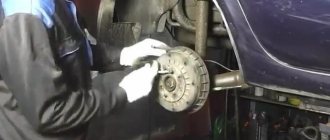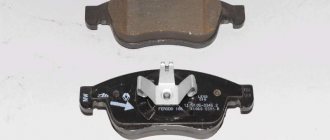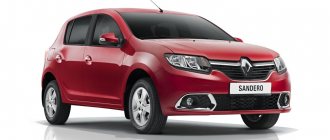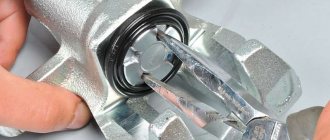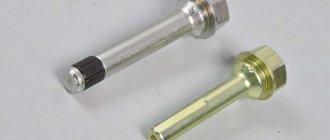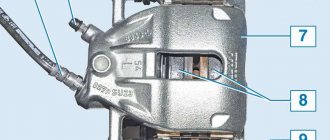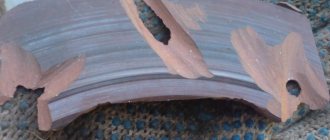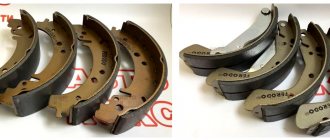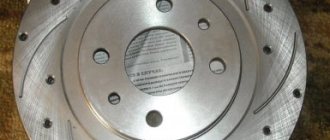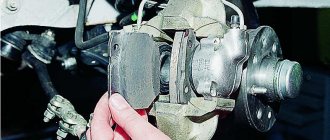Operations for replacing the front brake pads of Lada Granta
1. If your car has a brake pad wear indicator, disconnect the negative cable from the battery.
If there is no such option, then it is not necessary to disconnect the battery. 2. Since the vehicle will be without a front wheel or wheels, place it firmly on a vertical surface. Block the rear wheels with the handbrake and chocks. 3. Check the brake fluid level. If brake fluid comes up to the neck of the brake reservoir, pump out some of the fluid. 4. Using a screwdriver or using a chisel or pliers, bend the bent edge of the lock washer of the lower bolt (as shown in the photo) 5. Unscrew the lower bolt securing the bracket body. Hold the guide pin by the hexagon with the wrench. (as shown in the photo)
6. Now the bracket body can be rotated relative to the axis of the upper guide bolt.
Remove the pads installed on both sides of the brake disc. If the pads are pinched by the brake pistons, insert a screwdriver between the pads and the disc and push the pistons back. Also, the removal of the pads can be hampered by a rim formed as a result of disc wear. In this case, you can use an angle grinder to remove the bead along the edge of the disc. If you have pads with wear indicators, disconnect the wire that goes to them.
After this, the pads can be removed. 7. After you have removed the old pads, clean all brake parts from dirt and deposits, check for damage to the piston boots and for brake fluid leaks. 8. Now if you sharpened the lip to remove the pads, you need to remove it along the entire perimeter of the brake disc. You can carefully grind off the side on the spot using the same grinder. When processing a brake disc in place with a grinder, it is very easy to remove more thickness than necessary, be careful. If you remove the brake disc, then grinding off the side will be easier and more convenient; also, the removed brake disc can be installed on a lathe (ideal option) and remove a minimum layer in order to restore the parallelism of the surfaces of the brake disc (the minimum size between the surfaces should not be less than 17 ,8mm)
(The photo above shows a rim formed due to wear; such a rim not only interferes with effective braking due to the fact that it does not ensure an exact fit between the surfaces of the pad and disc, but can also create a squeak during friction against the guides located on the pads - the groove from wear is visible in the photo)
. It is much more convenient to grind the edge with a grinder on the removed disk
9. When installing new pads, it will be necessary to recess the piston into the cylinder. To do this, lower the body with the cylinder into place, take a screwdriver or mounting and, resting on the disk, carefully press the piston inward. You can also use large pliers (the body with the cylinder must be raised).
Make sure that during this operation the brake fluid does not overflow through the neck of the brake fluid reservoir located in the engine compartment on the master cylinder. If the piston does not move or does not move well, you can unscrew the bleeder fitting so that the brake fluid barely oozes through it. This will make it much easier to press the piston into place. Don’t forget to place a container under the fitting to catch any leaking fluid, and after installing the pads, tighten it back. If in this case the piston does not move, it will be necessary to replace the brake mechanism with a new one. 10 After installing the new pads, lower the bracket with the cylinder down, tighten the bottom bolt and secure it from unwinding with a lock washer. Press the brake pedal several times to set the proper clearance. Replace the wheel. Check the brake fluid level in the reservoir again.
Wear level diagnostics
If the car is not your age, then it is most likely equipped with a special device that signals when the pads are worn out. The wear sensor is activated and emits a characteristic squeak when the metal base touches the disc. Please note that it is not a grinding sound, but the sound of the device.
How can owners of Zhiguli cars determine the wear of an element, since such limiters were not installed on older VAZs. In this case, dear friends, you will have to remove the wheel and measure the thickness of the lining; it should be at least 1-1.5 mm. Another clear sign of worn pads is increased brake fluid consumption. The fact is that in the absence of support for the caliper in the form of a friction lining, its pistons extend as much as possible in the direction of the disc, which leads to loss of fluid. If you have been trained at a driving school, you probably remember the words of the instructor that the car signals in advance about any future problem, in order to avoid it you need to be a little attentive and ready for action, that is, repairs. Worn pads are no exception; they tell us this in a variety of ways:
- Skidding when braking;
- When you press the brake pedal, you feel it vibrating;
- Soft pedal with increased travel;
- Low braking efficiency;
- No parking brake even with the cable pulled.
If after all this you do not understand how to determine the need to replace the pads and you can already hear a grinding noise in the wheel whenever the car moves, immediately go to a car shop. In this case, comrades, all that is left of the braking element is a metal plate, which will ruin the working surface in a short period of time. After this, replacing the brake discs is just around the corner, if their thickness is less than 11mm, then your time has come. Therefore, it is better to pay attention to the car signals and get away with a slight fright.
Replacing the rear pads of Lada Granta
Replacement of rear brake pads on Lada Granta is required when the lining thickness is critical, which is about 1.5 millimeters. You can assess the condition of the pads even without removing the drums. To evaluate the front pad, a special inspection window is made in the brake shield, closed with a rubber plug. It is through this hole that you can see the thickness of the lining. Look at the photo below.
To replace the pads on a Lada Granta, you will definitely need a pit or overpass, because before removing the drums you need to loosen the handbrake cable, otherwise it is difficult to remove the brake mechanism. To access the parking brake adjustment area, remove the heat shield (pictured).
Using a 10mm socket, unscrew the four nuts securing the rear heat shield of the additional muffler.
Remove the rubber cushion from the front suspension bracket of the additional muffler. We move the heat shield forward, opening access to the parking brake adjustment unit.
Holding the adjusting nut of the cable end with a 13mm wrench, use a head of the same size to unscrew the locknut. By rotating the adjusting nut counterclockwise, we release the cables.
We remove the rear wheel and securely fix the Lada Granta body on a reliable factory-made stand.
If the car is equipped with an ABS anti-lock braking system, then the brake mechanism has some design differences. On a Lada Granta equipped with ABS, the wheel speed sensor should be disconnected from the brake shield to avoid damage to the sensor. Using the E-8 head, unscrew the screw securing the sensor and remove the sensor from the hole in the bracket attached to the brake mechanism shield.
Below, all work is shown on a Lada Granta without ABS. The differences will be discussed as the brake mechanism is disassembled.
Using a spanner wrench (preferably a hex head, so as not to tear off the edges) “7”, unscrew the two wheel guide pins and remove the brake drum.
Attention! Do not press the brake pedal after removing the drum, as the pistons may come out of the cylinder completely. If the Lada Granta drum cannot be removed, then, turning it evenly, use a hammer with a plastic tip (or an ordinary hammer through a wooden block) to strike the end of the drum. Usually the central part of the drum sours when mating with the metal of the hub
Usually the central part of the drum sours when mating with the metal of the hub
If the Lada Granta drum cannot be removed, then, turning it evenly, use a hammer with a plastic tip (or an ordinary hammer through a wooden block) to strike the end of the drum. Usually the central part of the drum sours when mating with the metal of the hub.
Next, you need to recess the pistons inside the working cylinder. To do this, we press on the pads with two mounting blades, leaning on the shoulder of the brake shield.
Using a screwdriver, pry the hook of the upper tension spring out of engagement with the block and remove the spring.
We remove the upper stops of the pads from the slots of the cylinder pistons and remove the spacer bar.
Using a screwdriver, pry the hook of the lower tension spring out of engagement with the block and remove the spring.
Using a screwdriver, remove the pressure spring from engagement with the block.
Remove the front pad.
Having disconnected the pressure spring from the rear block, lower the block and remove the parking brake drive lever from the hole in the parking brake cable tip.
Straighten the cotter pin and remove it from the hole in the parking brake lever pin. Remove the washer from your finger. Remove the lever and remove the finger.
Elements of the rear wheel brake mechanism of the Lada Granta in the following photo:
- 1 - front block of a car without ABS
- 2 - front block of a car with ABS
- 3 - spacer bar
- 4 - upper tension spring
- 5 - finger
- 6 - washer
- 7 - cotter pin
- 8 - rear block of a car with ABS
- 9 - rear block of a car without ABS
- 10 — parking brake lever
- 11 - lower tension spring
Replacing pads
Front pads are changed as standard:
- disassemble and remove the caliper;
- we take out the old pads;
- press in the piston;
- install new ones;
- We assemble the caliper.
For rear brakes, the replacement procedure is a little more complicated. To make the job easier, it is better to open the brake fluid reservoir cap in advance. Next, the algorithm is as follows:
- disassemble the drum;
- remove the ABS plate;
- remove the springs from the pads;
- disconnect the handbrake cable;
- we take out the old pads;
- compress the brake cylinder;
- install new pads;
- We reassemble in the reverse order (cable, springs, etc.).
Most often, you will need to bleed the brakes after replacing the pads, both front and rear.
Which pads are better to put on a VAZ?
Today there are a large number of companies on the market that sell linings for classic or modern VAZ cars. The following are the 10 best companies, according to consumer reviews and sales statistics.
10th place: AvtoVAZ
Typically, pads are used in everyday use where there is no need for increased performance or durability. The products are not suitable for fans of high-speed driving - the standard material does not like overheating, which can cause brake failure.
Users install such brake pads on the VAZ 2107 and other classic-type models.
Advantages:
- full compatibility with car models;
- sufficient reliability;
- moderate cost;
- durable base;
- available in every store.
Minuses:
- do not like overheating;
- may squeak a lot;
- a lot of debris is formed;
- do not withstand aggressive use.
9th place: DAFMI
The controversial reputation of the brand imposes certain restrictions on customer demand. On the one hand, users praise the products, saying that the pads wear out for a long time and hold critical loads well. Others insist on a large number of shortcomings, pointing out strong creaking, lack of effective braking even after prolonged grinding.
I am pleased with the minimum price of the products. If you have a limited budget, you can buy brand pads and play the lottery.
Advantages:
- minimum price;
- wide use;
- wide selection of models.
Flaws:
- questionable quality;
- there is a high probability of buying a defect.
8th place: TRUCKMAN
A competent approach to the arrangement of materials and technical processes during manufacturing eliminates crumbling of the linings due to overheating or shock loads. This provides the necessary durability and practicality of use.
On the other hand, increased rigidity of the composition negatively affects the comfort of use. The pads make a lot of noise and are not effective enough when exposed to water or snow, which forces motorists to be careful when driving in bad weather.
Advantages:
- optimal cost;
- good wear resistance;
- hold heat well;
- take a long time to grind in.
Flaws:
- fasten;
- require careful handling during operation in bad weather.
7th place: QUATRO FRENNI
The company's arsenal includes Vesta and XRay brake pads, as well as for other modern car models. Thanks to a wide range of organic mixtures and pad sizes, there is a choice to suit the individual needs of the user. Cheap modifications are perfect for production cars operated in standard mode without heavy loads. For modernized cars, semi-metallic linings with an increased margin of strength and durability are suitable.
Among the disadvantages, buyers highlight the fakes they come across, which greatly damages the brand’s reputation.
Advantages:
- wide choice of modifications;
- normal quality of budget products;
- low noise level.
Flaws:
a large number of fakes.
6th place: HERZOG
In Russia, the quality of the brand is well known. Brake pads can last 1.5-2 times longer than standard brake pads on Lada Largus or classic modifications. Users like the absence of squeaks, a normal reaction to overheating and minimal formation of chips, which ensures comfortable operation of the car and an adequate response to driver manipulations.
Advantages:
- good product quality;
- no squeaks;
- do not crumble when overheated;
- sufficient durability.
Flaws:
- slightly overpriced;
- there are fakes.
5th place: EZATI
Advantages:
- good braking performance;
- increased service life;
- does not eat discs - well-thought-out composition;
- sufficient distribution.
Flaws:
limited assortment.
Advantages:
decent value for money.
Flaws:
limited assortment.
3rd place: MARCON
Advantages:
- minimum price;
- sufficient efficiency;
- rapid heat removal from the contact zone.
Flaws:
- creaking;
- wipe off quickly.
2nd place: ROSDOT
Separately, we can highlight the company’s assortment. The company produces brake pads not only for VAZ, but also for imported cars.
Advantages:
- good quality;
- reasonable price.
Flaws:
wear out quickly.
1st place: STS
Advantages:
- impressive reliability;
- adequate price tag.
Flaws:
not detected when used correctly.
Which pads are better to put on a VAZ?
Today there are a large number of companies on the market that sell linings for classic or modern VAZ cars. The following are the 10 best companies, according to consumer reviews and sales statistics.
10th place: AvtoVAZ
Typically, pads are used in everyday use where there is no need for increased performance or durability. The products are not suitable for fans of high-speed driving - the standard material does not like overheating, which can cause brake failure.
Users install such brake pads on the VAZ 2107 and other classic-type models.
Advantages:
- full compatibility with car models;
- sufficient reliability;
- moderate cost;
- durable base;
- available in every store.
Minuses:
- do not like overheating;
- may squeak a lot;
- a lot of debris is formed;
- do not withstand aggressive use.
9th place: DAFMI
The controversial reputation of the brand imposes certain restrictions on customer demand. On the one hand, users praise the products, saying that the pads wear out for a long time and hold critical loads well. Others insist on a large number of shortcomings, pointing out strong creaking, lack of effective braking even after prolonged grinding.
I am pleased with the minimum price of the products. If you have a limited budget, you can buy brand pads and play the lottery.
Advantages:
- minimum price;
- wide use;
- wide selection of models.
Flaws:
- questionable quality;
- there is a high probability of buying a defect.
8th place: TRUCKMAN
A competent approach to the arrangement of materials and technical processes during manufacturing eliminates crumbling of the linings due to overheating or shock loads. This provides the necessary durability and practicality of use.
On the other hand, increased rigidity of the composition negatively affects the comfort of use. The pads make a lot of noise and are not effective enough when exposed to water or snow, which forces motorists to be careful when driving in bad weather.
Advantages:
- optimal cost;
- good wear resistance;
- hold heat well;
- take a long time to grind in.
Flaws:
- fasten;
- require careful handling during operation in bad weather.
7th place: QUATRO FRENNI
The company's arsenal includes Vesta and XRay brake pads, as well as for other modern car models. Thanks to a wide range of organic mixtures and pad sizes, there is a choice to suit the individual needs of the user. Cheap modifications are perfect for production cars operated in standard mode without heavy loads. For modernized cars, semi-metallic linings with an increased margin of strength and durability are suitable.
Among the disadvantages, buyers highlight the fakes they come across, which greatly damages the brand’s reputation.
Advantages:
- wide choice of modifications;
- normal quality of budget products;
- low noise level.
Flaws:
a large number of fakes.
6th place: HERZOG
In Russia, the quality of the brand is well known. Brake pads can last 1.5-2 times longer than standard brake pads on Lada Largus or classic modifications. Users like the absence of squeaks, a normal reaction to overheating and minimal formation of chips, which ensures comfortable operation of the car and an adequate response to driver manipulations.
Advantages:
- good product quality;
- no squeaks;
- do not crumble when overheated;
- sufficient durability.
Flaws:
- slightly overpriced;
- there are fakes.
5th place: EZATI
Advantages:
- good braking performance;
- increased service life;
- does not eat discs - well-thought-out composition;
- sufficient distribution.
Flaws:
limited assortment.
Advantages:
decent value for money.
Flaws:
limited assortment.
3rd place: MARCON
Advantages:
- minimum price;
- sufficient efficiency;
- rapid heat removal from the contact zone.
Flaws:
- creaking;
- wipe off quickly.
2nd place: ROSDOT
Separately, we can highlight the company’s assortment. The company produces brake pads not only for VAZ, but also for imported cars.
Advantages:
- good quality;
- reasonable price.
Flaws:
wear out quickly.
1st place: STS
Advantages:
- impressive reliability;
- adequate price tag.
Flaws:
not detected when used correctly.
Comparative characteristics
To understand which model from the rating to select for your vehicle, you need to carefully study the comparative characteristics of the models.
Table. Comparative characteristics of brake discs.
| Model | Disk type | Peculiarities | Installation side | Diameter mm | price, rub. |
| Alnas Sport 2112-3501070-01 | Ventilated | With perforation | Front axle | 260 | From 1,750 |
| ATE PowerDisc | Ventilated | Notched | Front axle | 300 | From 1 850 |
| BREMBO MAX 09.8903.75 | Ventilated | Notched | Front axle | 260 | From 2 250 |
| Bosch 0986479346 | Ventilated | Notched | Front axle | 260 | From 1 000 |
| TRW DF7257 | Full | Varnished | Rear axle | 288 | From 1 880 |
| BM BDV 292 | Ventilated | Notched | Rear axle | 285 | From 1 740 |
How to independently determine the wear of brake discs
- We install the machine within the perimeter of the repair area. Jack up and remove the wheel, having previously activated the parking brake;
- We carry out troubleshooting of the brake caliper, inspect for cracks, chips, and corrosion;
- We check the integrity of the fluid supply line, rubber boots, cuffs;
- Using a caliper we measure the actual thickness of the disc. We compare the obtained data with the parameters specified in the operating instructions.
We make a final decision on the advisability of grooving and replacement with a new disc.
The need for prevention will also be indicated by the following:
- increase in braking distance;
- applying force when pressing the brake pedal;
- stopping is accompanied by a creaking, grinding sound in the area of the front axle;
- liquid is systematically drained from the expansion tank of the master cylinder;
- The brake pedal vibrates when pressed.
In a car service environment, the process looks similar. Except for minor additions.
Symptoms of wear parts
While driving, there are several signs that you can use to determine when it’s time to change the pads of the front or rear brakes, or even all together. The symptoms are:
- a metallic grinding sound when you press the pedal indicates complete wear of the linings;
- increased travel of the brake pedal, its vibration when pressed;
- when braking, there is a feeling that the front or rear of the car is being pulled to the side, and on a slippery road the car easily goes into a skid;
- the handbrake does not work properly;
- To stop you need to put more force on the pedal.
If, when braking, a metallic grinding and squeaking sound is heard from the wheels, then the question of how long to change the unusable parts is no longer worth asking. Replacement must be done urgently, since there are no friction linings left and the steel base is rubbing against the working surface of the disk.
Never allow the brakes to wear out completely, otherwise you will have to replace the discs along with the pads, which is significantly more expensive.
If you notice one or more symptoms indicating problems with the wheel brake mechanisms, check the condition of the linings. Recommendations for performing diagnostics are as follows:
- If your car is equipped with alloy wheels with large holes, then you won’t have to disassemble anything to inspect the front calipers. If necessary, jack up the car to align the disc opening against the brake mechanism.
- Wheels with steel rims must be removed. Inspect the front brake pads and evaluate the thickness of the linings. If it is less than 3 mm, the parts should be replaced immediately. With a thickness of 3-5 mm you can drive another 1-2 thousand km, no more.
- Rear brakes are disc or drum. The first ones are examined similarly to the front ones, but the second ones will have to be disassembled. Remove the wheel and release the handbrake, then unscrew the drum and carefully knock it off the hub. Unlike the front pads, the rear pads need to be changed when the thickness is 1.5-2 mm.
When, as a result of diagnostics, wear of elements close to the maximum is detected, but replacement is postponed for various reasons, drive carefully and without haste. It happens that a worn lining comes off completely when you press the pedal sharply .
When conducting diagnostics, pay attention to the working surface of the brake drums and discs. If its wear is 2 mm or more (determined by the depth of the groove with a caliper), then the part must be replaced.
Replacing rear pads on a Lada Granta with ABS
Replacing brake pads in Lada Granta drum brakes, it would seem, should not cause any difficulties. Nevertheless, there are cases when inept handling of the brake mechanism ends in damage to the brake drum, friction linings of brake pads or brake cylinder boots. To avoid such disgrace, we will find out the secrets that the Lada Grant with ABS has related to drum brakes.
How to check brake pad wear on a Grant
No one will bother replacing brake pads right away. There are reasons for this, and mileage does not play a major role here. The service life of VAZ pads is quite difficult to predict. The level of wear on the rear drum brake pads greatly depends on the quality of the friction linings and their composition, as well as on the driving style.
First of all, poor performance of the handbrake will indicate wear of the rear pads. When braking under normal conditions, it is difficult to feel the wear of the rear pads, since 75% of the braking force falls on the front wheels.
But Granta has one clue - this is a hatch in the brake shield, closed with a rubber plug. It can be found if you pick up the dirt on the back of the shield.
If you open the hatch, the wear of the front pad will be clearly visible, and the front pad wears out much faster than the rear one.
If you replace the pads on only one side, the car may pull to the side when braking, especially on slippery roads.
Changing brake pads on a Grant with ABS
The process of replacing pads on a Grant with and without ABS differs only in small details. Firstly, a drive disc is installed behind the brake drum. Secondly, there is an ABS sensor installed in the brake shield on the rear side, which will need to be removed. Thirdly, the pads for cars with ABS have technological holes for this sensor.
First of all, you need to release the handbrake cables. If we still have the factory heat protection installed above the muffler, it will have to be removed by unscrewing 4 nuts.
Then we simply unscrew the handbrake tensioner locknut with a 13 mm wrench, and loosen the second nut until it stops.
We get to the brake mechanism. We fix the car with wheel chocks, jack up the right or left rear part, having previously removed the wheel bolts. We remove the wheel.
Using a socket or 7 mm spanner, unscrew the guide pins that secure the drum to the hub.
How to remove a brake drum on a Grant
To remove the brake drum without any problems, we use the civilized “impactless” method. We look carefully at the brake drum holes, located at the same diameter as the guide holes. They are diametrically opposite and have threads cut into them.
In order to remove the drum from the hub without effort and a hammer, we screw two bolts 50-60 mm long with the same threads as on the guide pins into these holes.
We screw the bolts evenly, 15.-2 turns on each side.
As a result, the drum will overcome the resistance of the pads even if a groove has formed on the working surface, and will be removed like clockwork.
Now the entire brake mechanism is within reach. First of all, we remove the master disk; nothing else holds it.
Typical causes of wear on brake system components
- Long-term operation without intermediate prevention;
- Mechanical damage to the caliper or steering knuckle, resulting in deformation of the lining;
- Deformation, and as a result, creaking of brake pads on Grant;
- Purchase and subsequent installation of low quality parts;
- Violation of installation technology;
- Aggressive driving style of a vehicle;
- Insufficient amount of fluid in the expansion tank of the master cylinder;
- Damage to the supply line DOT – 4;
- Working cylinder jammed.
Brake pads for Lada Granta: replacing front and rear pads - AutoExpert
Effective brakes are not only a guarantee of safety, but also a short braking distance and the prevention of an emergency. Grant brake pads can be replaced either independently or at a service center. The deciding factor when choosing is the size of the budget that the owner is willing to spend on maintenance.
Articles of brake pads Lada Granta
Let's denote that the Granta's brake circuit is presented in a classic style: front disc and rear drum pads. This type/scheme was borrowed from Kalina, Priora, and earlier models.
| № | Article/OEM/brand | Price, rub.)* |
| 1. | Original catalog items 21100-3501080 | from 900 |
| 2. | 21100-3501089 | from 1200 |
| 3. | Disc TRW LADA Granta Article: GDB1384 | from 1450 |
| 4. | rear TRW Granta, Kalina, Datsun art. GS8210 | from 1300 |
| 5. | Allied Nippon ADB2794 (set) | from 3200 |
| 6. | Allied Nippon ADB2795 with calipers from Lada Priora 2110 | from 1100 |
| 7. | Allied Nippon ADB0173 | from 1100 |
| 8. | Rear brake pads Grant Sport / Kalina article number: 21905-3502080-87 | from 1100 – 1200 |
| 9. | Front brake pads LADA Granta Sport / LADA Kalina-2 Sport | from 1200 |
*Prices are current as of September 18, 2018.
The list presented is not exhaustive and is for informational purposes only. The manufacturer allows the purchase and subsequent installation of components not listed in the list. The main requirement for parts is quality workmanship and professional installation. Among foreign analogues, Lada Granta liftback brake pads are in high demand:
- BOSCH 0 986491700, 0 986495214;
- ICER 181308;
- Lucas – Girling E9 90R-01111/479;
- LYNXauto BD-4601, LYNXauto BD-4605;
- FENOX BP40005O7;
- FERODO FDB527;
- TRW 21170.
What you need to know about Granta Sport pads
In the Sport modification, all four calipers are disc type. Friction linings are metallic and semi-metallic. Ceramic and organic friction linings are not installed on the Lada model. The difference between the last two types is the presence of ceramic and Kevlar fiber.
There is no need to mention the advantages of organics and ceramics, since everyone knows that they are developed using the most modern technologies and provide maximum braking effect. The exorbitant cost is a significant drawback, which for many becomes a stumbling block.
Grant brake pad life
The manufacturer in the operating manual indicates a replacement interval of 30,000 km. Taking into account the conditions of use of the machine, the quality of spare parts, and climatic temperatures, we reduce the period for replacing brake pads on Grant by a third.
To maintain the brake system in good condition, it is enough to carry out maintenance every 15,000 km. If defects or damage are found, replace with new elements.
How to choose and which ones are better to buy brake pads for Granta
The supply of brake system elements for Grant is carried out by. Specialization: trucks and cars.
Since the end of 2012, JSC TIIR has been supplying front overlays made of composite material (1118-3501090). The peculiarity of the components is the absence of anti-creaking plates in the design.
A special mastic is applied to the back side to suppress noise, vibrations, and squeaks.
The technology showed a number of shortcomings and in 2013 TIIR supplied new pads under the index (2192-3501090-10). They are also made of composite material under the number TIIR-299.
Anti-squeak plates “Nulok” for Lada Granta are installed on the outside. The rear circuit is equipped with disc-type pads (21920-3502090-10). Components are also supplied by JSC TIIR.
The number of the composite material TIIR is 444.
Diagnostics of friction lining wear level
Most modern cars are equipped with special digital wear sensors. When the programmed level is reached, an indicator light is activated on the central instrument panel, indicating a breakdown of the brake circuit.
Unfortunately, the Lada is not yet equipped with digital sensors; you need to navigate by the actual thickness of the body of the lining. The maximum permissible threshold for using the body is 1.5 mm. Above the specified limit, the operation of the technical device is not safe. The degree of wear can be determined by removing each wheel and measuring the thickness with a caliper.
Alternative option: turn the steering wheel to the extreme left/right position, visually assess the thickness without resorting to dismantling work. The above recommendation only applies to the front circuit. For rear wheels, unconditional removal of discs.
Popular products of the spare parts group - Brake pads for LADA GRANTA Liftback (2191_)
Brake system LADA GRANTA Liftback (2191_) Front disc brake pads Lada Samara/110/112 86>18 FERODO FDB527
manufacturer: FERODO (Great Britain) article: FDB527
1 200 a
Brake system LADA GRANTA Liftback (2191_) Front brake pads with sensor Lada 110/111/112 89>18 GIRLING 6114461
manufacturer: GIRLING (Germany) article number: 6114461
1 340 a
Brake system LADA GRANTA Liftback (2191_) Front brake pads Lada Samara/110/112 85>19 Zaz Tavria 98>07 TRW GDB1446
manufacturer: TRW (Germany) article number: GDB1446
1 530 a
Brake system LADA GRANTA Liftback (2191_) Front disc brake pads Lada Samara/110/112 86>19 BREMBO P41003
manufacturer: BREMBO (Italy) article number: P41003
1 600 a
Brake system LADA GRANTA Liftback (2191_) Front brake pads Lada 110/111/112 89>18 KOTL 39KT
manufacturer: KOTL (Russia) article number: 39KT
900a
Brake system LADA GRANTA Liftback (2191_) Front disc brake pads Lada Nova/Riva/Samara 85>19 KRONER K002110
manufacturer: KRONER (Germany) article number: K002110
480a
Brake system LADA GRANTA Liftback (2191_) Front brake pads Lada Samara/110/112 86>19 TEXTAR 2117002
manufacturer: TEXTAR (Germany) article number: 2117002
1 680 a
Brake system LADA GRANTA Liftback (2191_) Front disc brake pads Lada Samara/110/112 86>18 TRIALLI PF973
manufacturer: TRIALLI (Italy) article number: PF973
610a
Brake system LADA GRANTA Liftback (2191_) Disc brake pads Lada 110/111/112 89>18 WEEN 151-1102
manufacturer: WEEN (Netherlands) article number: 151-1102
1 190 a
Brake system LADA GRANTA Liftback (2191_) Front disc brake pads Lada 110/111/112 89>18 LADA 11180350108000
manufacturer: LADA article: 11180350108000
720a
Brake system LADA GRANTA Liftback (2191_) Front disc brake pads Lada Nova/Riva/Samara 85>19 Zaz Tavria 89>07 Datsun mi-DO/on-DO 14>17 ZEKKERT bs-1927
manufacturer: ZEKKERT (Germany) article number: bs-1927
900a
Brake system LADA GRANTA Liftback (2191_) Disc brake pads Lada 110/111/112 89>18 ROADHOUSE 222102
manufacturer: ROADHOUSE (Spain) article number: 222102
1 510 a
You can also view all spare parts LADA GRANTA Liftback (2191_)
Cylinder replacement
I also decided to replace the working cylinder, since brake fluid was leaking from it. In order not to disassemble it again later, it is better to replace it immediately. Moreover, the brake pipe and the cylinder itself unscrewed easily.
I bought a new cylinder (more precisely, 2 at once - for the other side).
The main thing is that the tube unscrews, and the mounting bolts can be broken. New ones will still be installed. To prevent liquid from flowing from the tube, you can put a rubber cap on it, which is installed on the new cylinder.
Now you need to thoroughly clean everything from rust with a wire brush. When installing a new brake cylinder, I recommend lubricating the bolt threads with graphite. Next, insert the tube and loosen the bypass valve. The liquid will flow by gravity and fill the working cavity. When it starts to come out of the valve, you can tighten it.
What you need to know about Granta Sport pads
In the Sport modification, all four calipers are disc type. Friction linings are metallic and semi-metallic. Ceramic and organic friction linings are not installed on the Lada model. The difference between the last two types is the presence of ceramic and Kevlar fiber.
There is no need to mention the advantages of organics and ceramics, since everyone knows that they are developed using the most modern technologies and provide maximum braking effect. The exorbitant cost is a significant drawback, which for many becomes a stumbling block.
Comparative characteristics
To understand which model from the rating to select for your vehicle, you need to carefully study the comparative characteristics of the models.
Table. Comparative characteristics of brake discs.
| Model | Disk type | Peculiarities | Installation side | Diameter mm | price, rub. |
| Alnas Sport 2112-3501070-01 | Ventilated | With perforation | Front axle | 260 | From 1,750 |
| ATE PowerDisc | Ventilated | Notched | Front axle | 300 | From 1 850 |
| BREMBO MAX 09.8903.75 | Ventilated | Notched | Front axle | 260 | From 2 250 |
| Bosch 0986479346 | Ventilated | Notched | Front axle | 260 | From 1 000 |
| TRW DF7257 | Full | Varnished | Rear axle | 288 | From 1 880 |
| BM BDV 292 | Ventilated | Notched | Rear axle | 285 | From 1 740 |
